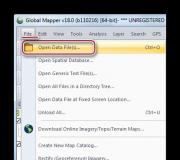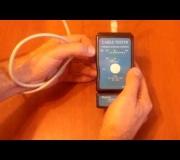How to remove restorator from the context menu. Explorer context menus
For those who use the operating room Windows system not long ago, the idea was to remove items from context menu the conductor is unlikely to be particularly interested. But if you have been working with Windows for quite a long time without reinstalling and install various programs on your computer from time to time, then it is likely that your context menu has grown to serious sizes and looks something like this:

To make the context menu more convenient, you can clear it of unnecessary and unused items. Eat special programs to edit the context menu, such as FileMenu Tools or ShellExView. However, in this article we will learn how to remove items from the context menu using standard Windows OS tools.
Removing items from the context menu
The easiest way to remove items from the context menu is to look in the program settings and uncheck the corresponding items.

However, this is not always possible, since some programs do not provide a function for disabling items in the Explorer context menu. In this case, you can use the registry editor and remove items from the context menu, so to speak, manually.
I would like to warn you that before carrying out any manipulations with the system Windows registry, it is highly advisable to save first backup copy registry in a safe place. This is quite easy to do. In the registry window you need to open the menu File and select item Export.


To restore the registry using a backup copy, you only need to double-click on the previously saved file and agree to add information to the registry.

So, we launch the System Registry Editor using the command regedit in the window Execute(Win+R). Then you need to go to the registry branch: HKEY_CLASSES_ROOT\*\shellex\ContextMenuHandlers. Here you will see most of the context menu items.

For removing unnecessary element from the context menu you need to click on it right click mouse and select the item Delete.
If some context menu element could not be found in the above registry section, then it is located here - HKEY_CLASSES_ROOT\AllFilesystemObjects\Shellex\ContextMenuHandlers.
In order to remove items from the context menu that appear when you right-click on a folder, go to the section HKEY_CLASSES_ROOT\Directory\Shellex\ContextMenuHandlers, as well as in the section HKEY_CLASSES_ROOT\Folder\ShellEx\ContextMenuHandlers.
If you need to remove any item from the context menu To open with, then you need to look here: HKEY_CLASSES_ROOT\*\OoenWithList.
By the way, if, when you try to make changes to the system registry, the message “Editing the registry is prohibited by the system administrator” appears, advice from . It describes in detail how to remove the ban on access to registry editing tools.
Still have questions? - We will answer them for FREE
You probably noticed that in every assembly Windows contextual the menu is different. In addition, often after installation various programs are added to the context menu unnecessary items. For example, after installing any player, you will definitely see new item for the right mouse button. That is, when we right-click on any file to open it in specified program, the option to run using this program will be displayed.
Here, for example, is my context menu:

It's not quite small anymore.
Over time, there are a lot of items in the context menu, in short it gets clogged unnecessary rubbish. And the question arises: how to get rid of “unnecessary” items? Although many programs have already been created for these purposes, let’s consider how this can be solved using standard means systems.
IN system registry all data about the operation of programs is stored and Windows components. In this regard, careless handling of the registry and the slightest change can greatly affect the operation of the system, so be careful when making changes to it.
How to remove unnecessary items from the context menu?
Let's go to Start press the button Execute.

In the window that opens, enter the command Regedit and click OK .

Opening following folders:
HKEY_CLASSES_ROOT, *, shellexe, ContextMenuHandlers

Having reached this path we need to do the following actions. Right-click on the folder menu item that we want to delete. Let's say I want to remove shortcuts from the context menu − Notepad, AIMP player. In the list that opens, select Delete.
Over time, contextual Windows menu is growing. The longer you use your computer and the more programs you install, the longer it becomes. You can clean it and remove unnecessary fields using CCleaner programs or editing the registry.
First way. Go to the Piriform website in the downloads section and download the free CCleaner version. There is only one difference from the paid version - there is no technical support.
Install the program and run it. If you wish, you can change the interface language to Russian.

Go to the “Service” section and select “Startup” in the menu that appears. There are several tabs here, we are interested in the “Context Menu”. Go to this tab, you will see a list of programs that have added their commands to the context menu, and their status: enabled or not. Those commands that you do not use can be deleted. To do this, right-click on the application field and select the “Delete” option. Return remote command This is possible only after reinstalling the application or reconfiguring it.


However, you can clean the menu without programs - by making changes to the registry manually. To do this, open the registry editor (Windows/system32/regedit.exe or through a search in Start).

Find the HKEY_CLASSES_ROOT\*\shellex\ContextMenuHandlers branch. It shows the commands that appear in the context menu of files of any type. Remove values that you think are unnecessary.

Commands associated with specific file types can be found in folders under the HKEY_CLASSES_ROOT branch. Select a file extension that you see frequently and remove unused commands.
If you've ever right-clicked on something and wondered where that junk came from, you're not alone.
By Windows default includes many options in this context menu, and the list grows as you install new applications. Sometimes it feels like every app is fighting for a piece of your context menu, even though most of us don't even use half the commands.
Today we'll show you how you can remove items by editing your registry, as well as an easier cleaning method using a couple of free third party applications. We'll also show you how to add some useful commands. Without special effort you can only clog the context menu useful commands– optimized and efficient.
Editing the context menu registry
If you want to clear the context menu in a rough way, then you can do this from the Registry Editor without the need for a third party software. We'll move on to lighter tools later, but we think this introduction will help you understand how other tools work with the registry.
Standard warning: Registry Editor is powerful tool and improper use can make your system unstable or even inoperable.
Open Registry Editor by pressing the Win + R key combination and typing regedit. Press Enter to open Registry Editor and then give permission to make changes to your computer.
Unfortunately, the items populating your context menu are in different places registry You can find most context menu items used for files and folders in one of the following registry keys:
HKEY_CLASSES_ROOT\*\shell HKEY_CLASSES_ROOT\*\shellex\ContextMenuHandlers HKEY_CLASSES_ROOT\AllFileSystemObjects\ShellEx
You'll find context menu items specific to folders in one of these sections:
HKEY_CLASSES_ROOT\Directory\shell HKEY_CLASSES_ROOT\Directory\shellex\ContextMenuHandlers
You'll need to handle the context menu items found in these locations a little differently, so keep reading and we'll explain how to do it. On this moment It may be convenient to find each of these places in the registry and adding to favorites list, to make it easier to find later.
Remove Shell Elements
Let's look at one point as an example. I'm using VLC video player. When I installed it, VLC added a context menu item called "Add to VLC Playlist". I never use it and most likely won't use it.

Here's how we get rid of this menu item. In Registry Editor, navigate to the following key:
HKEY_CLASSES_ROOT\Directory\shell\AddtoPlaylistVLC
I noticed the AddtoPlaylistVLC key while browsing the shell, looking for items to remove. Elements under a regular shell key are usually very easy to locate and understand the meaning.

We have several options on how to deal with this. We could simply remove this AddToPlaylistVLC completely, and this will remove the item from the context menu. However, if you don't back up your registry or export the key first, you won't have an easy time getting it back if you change your mind.
Second option - disable the key rather than deleting it. To do this, simply right-click AddToPlaylistVLC or whatever key you are working with and select Create → String parameter. Name the new string value LegacyDisable.

Once you create LegacyDisable, the changes will take place immediately. Right-click a file or folder in File Explorer and you'll see that the "Add to VLC Playlist" item has disappeared from the context menu.
There is also a third option. If you occasionally use a menu item but don't want it to clutter up the regular context menu, you can hide it in an expanded context menu that you'll only see when you hold Shift while right-clicking a file or folder.
To do this, right-click AddToPlaylistVLC or whatever key you are working with and select Create → String value. Name it Extended.
Now it will only appear if you right-click on the folder while holding Shift.
Remove Shellex elements
You may have noticed that some of the common registry keys we listed at the top of this section are named "shellex" (shell extension) instead of "shell". You'll have to handle these types of keys a little differently.
As an example, we'll go to one of those keys we talked about:
HKEY_CLASSES_ROOT\Directory\shellex\ContextMenuHandlers
Shellex elements are a little more difficult to decipher, but you can identify the element by the key name on the left. Here we will work with Yandex.Disk.3 inside ContextMenuHandlers.

When Yandex.Disk is installed, it will add the “Copy link to Yandex.Disk” command to the context menu. Since I'm more of a drag and drop guy, I've never used this command and I'm going to get rid of it.
You won't be able to use the LegacyDisable and Extended tricks mentioned above here. But, you can delete the entire DropboxExt key to remove it from the context menu (and be sure to return the key if you do this), but there is an easy way to disable it. Simply select the key on the left and then double-click on the value (Default) to open the properties window.

In the properties window, in the “Value” field, change the existing value by placing several dashes in front of it, without removing the existing characters. Then, if you change your mind, you can simply go back and remove the dash. When everything is ready, click OK.

The change will be immediate: try right-clicking something in Explorer and see that the command disappears.
Unfortunately, when it comes to shellex keys, there is no way to hide them in the extended context menu the way we did with shell items. They can either be deleted or disabled.
Explore other locations by file type
If you want to remove context menu items that you only see when you right-click on certain types files, you can also get rid of them. These elements are stored in elswhere. To find them, you need to first look for the file extension key in the HKEY_CLASSES_ROOT section.
For example, you want to remove the menu item to open Excel document(XLSX) in Excel when you right-click it. Why would you do this? This is just an example. Other applications can also add different types commands you don't need.
You can start by looking at the following registry key for the XLSX extension:
HKEY_CLASSES_ROOT\.xlsx
Data Column Meaning for the key (Default) lets you know that the actual file type is Excel.Sheet.12.

Now you can go to this extension:
HKEY_CLASSES_ROOT\Excel.Sheet.12\shell

Now that you've found the correct shell key, you can use the same methods we described in the previous section about "shell" elements to remove, disable, or hide an item in the extended context menu. Remember string values LegacyDisable And Extended? Yes, these techniques work here too.
Managing the context menu using NirSoft Utilities
Now that you know how to do something difficult, let's take a look at the easy way. Instead of editing the registry, you can download two tools from NirSoft to clean up the context menu.
Why two tools? Because one of them handles ordinary elements shell, and one handles shellex elements. They are much easier to use than editing the registry, but a behind-the-scenes understanding of how these tools handle the registry will give you the ability to make sense of all the items these tools display.
Start by downloading both tools. The first tool is ShellMenuView, which handles regular shell items. The second tool is ShellExView, which handles shellex elements. Scroll down to the bottom of both of these pages to find the download links. The tools work with almost any version of Windows, from 98 all the way up to 10.
In the ShellMenuView window, simply look through the list until you find the item you want to disable. You can only disable items using these tools, not remove them or hide them in the advanced context menu. And by the way, these tools disable items by creating a LegacyDisable inside the corresponding key - just like we did when editing the registry manually.
When you find required element, click the Disable button on the toolbar (red light).

Another benefit of using these tools is that you can select multiple items and then disable them all at once. In our example, we disabled the "Add to VLC Playlist" item only when right-clicking on a folder (the same example we used in the registry key earlier), but we could easily select all the "Add to VLC Playlist" items and then click Disable to remove this command from the context menu of all supported file types.
Once you are done removing shell elements, the next step is to run the ShellExView tool and remove shellex elements. This works exactly the same as the first tool. Simply select one or more items and then click the Disable button to remove items from the context menu.

In the end, you'll be surprised at how much more enjoyable it is to use a clean context menu that only has necessary commands. So, what are you waiting for? It's time to start making those context menus more useful!



